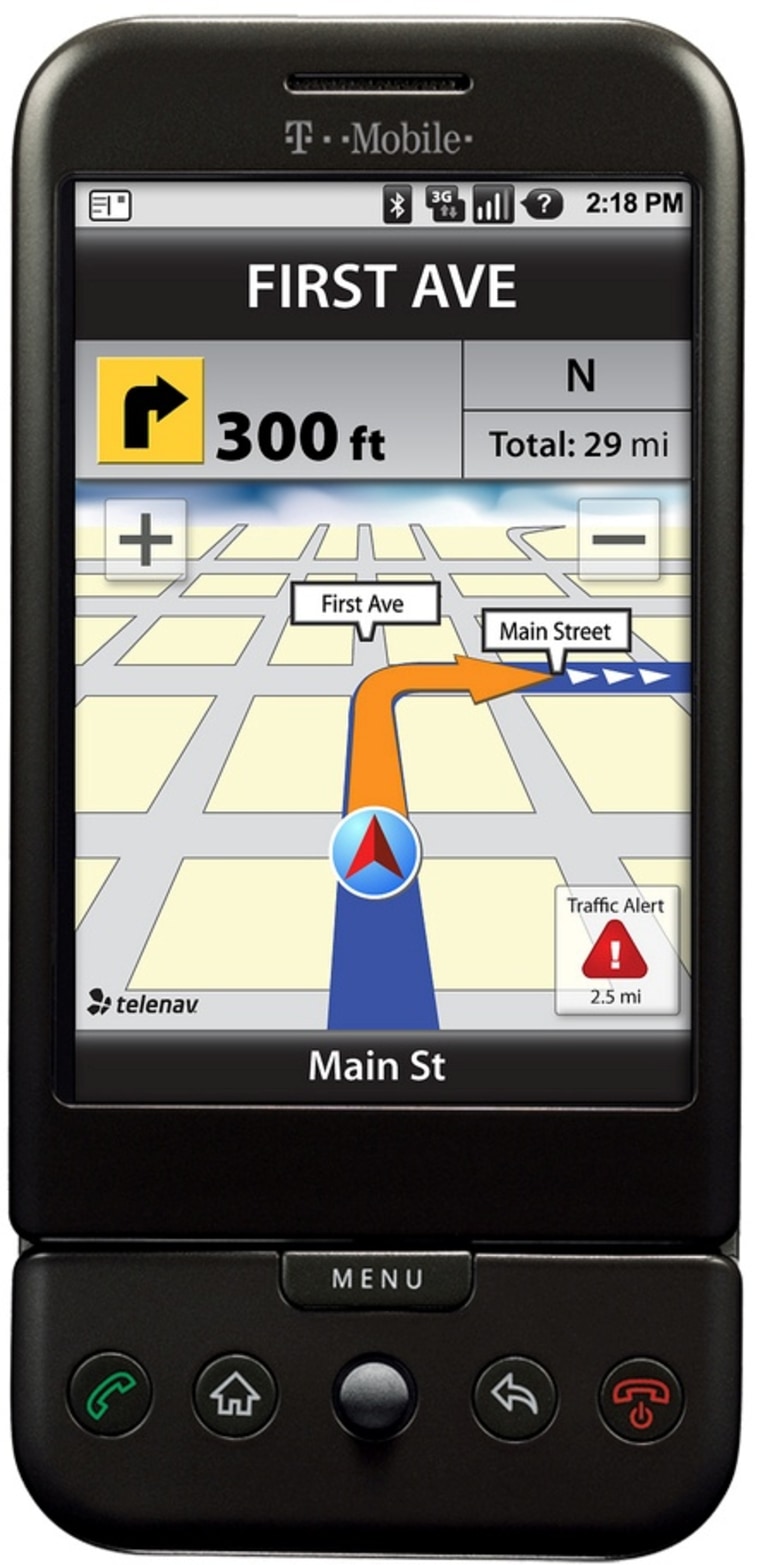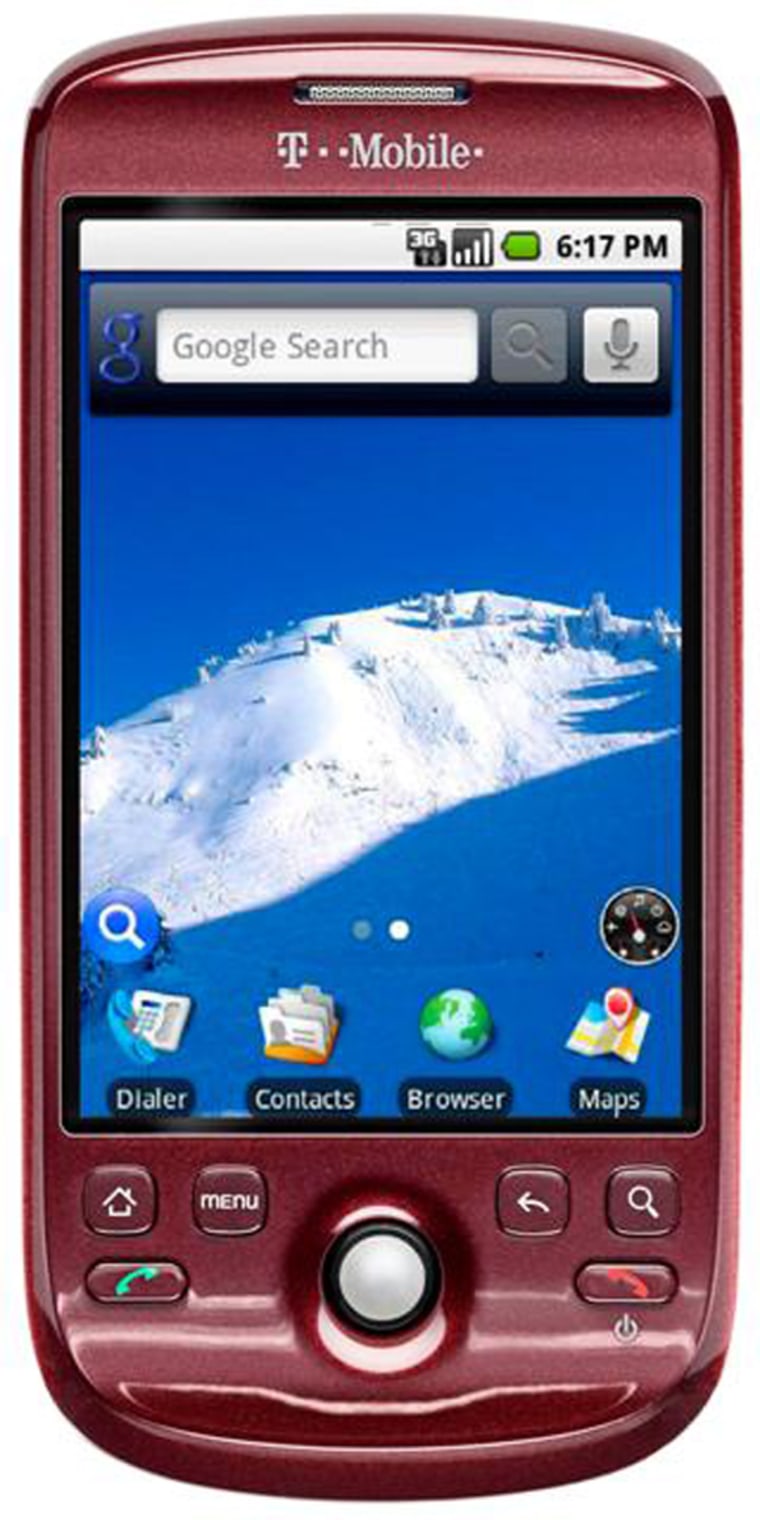Saying “T-Mobile G1” isn’t too bad, but “T-Mobile myTouch 3G with Google” is a mouthful. Once you get past the name, the phone itself is an impressive follow-up to the first Android phone that was released last fall. The “myTouch 3G” is due out Aug. 5, and after initial testing of the phone, I find it’s a winning alternative to the iPhone, BlackBerry and the Palm Pre for those aren’t enamored with those choices.
The phone betters its older sibling in looks — sleeker and lighter — and performance with better battery life. Those improvements are mainly because the myTouch is a touchscreen-only phone; the G1 is touchscreen but also includes a slide-out QWERTY keyboard, which adds weight and drains energy, T-Mobile says. The myTouch weighs 4.1 ounces and has a rated talk-time battery life of up to six hours; the G1 is a heftier 5.6 ounces with a rated battery life of up to five hours, although it often didn’t last that long.
Battery life is a big issue with smartphones, with Wi-Fi and GPS radio use, Web surfing and downloads and e-mail all draining the power. T-Mobile says the battery in the myTouch is physically larger than the G1’s and also has better radio performance and power management, in large part because it doesn’t have a physical keyboard.
After eight hours of running the myTouch, including a few hours on standby, the battery meter said it was at 52 percent; and after 12 hours, it was at 29 percent. That said, I was running the phone through different paces, sometimes using Wi-Fi, which drains the battery more quickly, because I could not get 3G, or faster wireless, network service in my area.
The phone’s 3.2-inch display is the same size as the G1’s and both phones, made by HTC, use the same Qualcomm 528-MHz processor. The myTouch is 4.45 inches high, 2.19 inches wide and .58 of an inch thick, compared to its predecessor, which is 4.6 inches high, 2.1 inches wide and .62 of an inch thick. It feels good in hand, just the right size, and is narrower than the iPhone, which is 2.4 inches wide.

The myTouch comes with 512 megabytes of internal memory, double the internal memory of the G1, and a pre-installed 4GB removable microSD card.
Less bulk is definitely welcome. But the sleeker profile comes with some tradeoffs. The seven buttons, including a trackball, on the front of the device feel a little crowded and too close together for comfort, unlike the buttons on the G1.
The myTouch's on-screen menus also can be a little dicey, especially when dealing with e-mail. It's a little too easy to hit the wrong key. On-screen buttons for "reply," "reply all" and "delete" are positioned at the bottom of the screen close to the hardware buttons.
The "delete" button in particular is near the physical "back" button, and several times I thought I hit that button, but found I had inadvertently hit "delete," and away went my e-mail.
The touchscreen itself is very responsive, and as with the G1, users touch, tap, swipe and scroll, and have use of on-screen menus, as well as a trackball to navigate. The accelerometer, the motion sensor that switches the screen from portrait to landscape mode, is also quite nimble.
When it comes to e-mail, there's good news and some bad. Unlike the G1, the myTouch comes with built-in support for Microsoft Exchange Active Sync, so work e-mail can be received on the phone. (Msnbc.com is a joint venture of Microsoft and NBC Universal.) That's a huge plus, and it was easy and quick to set up.
However, "work" e-mail has its own icon, or "widget," to click on, separate from personal e-mail which is grouped together and accessed by clicking on a separate widget. It would be handier to get to all e-mail with one click, rather than going back and forth between widgets.
Strong looks, software
Fans of the Android, open-source operating system may have felt a little let down with the G1's boxy design, but will have nothing to be embarassed about with the myTouch (which comes in black, white and merlot). The phone's looks match the power of the software, which is considerable.
Google shepherded Android, which is based on Linux, and an updated Android operating systen, version 1.5, also works to full advantage on the new phone. The new OS, which was released a few months ago, allows for video recording and speech recognition features, and the myTouch has both built-in (Those G1 users who upgraded to 1.5 can take advantage of it). Both Android phones have 3.2-megapixel cameras.
Video on the myTouch may benefit from further software and hardware refinements, and for now, it seems passable, with the camera pan seeming a little slow. It's not the phone's selling point, but it is good to have, with more phones — including the latest iPhone — adding video to their feature sets.
A notification "bar" on the screen also provides updates from applications that are most important to the user, one of the "personalization" elements to the phone that T-Mobile is pushing (hence the "myTouch" part of the name).
The phone, which costs $199.99 with a new, two-year service agreement, also has an Amazon MP3 Store application on it, and the music player also supports AAC, AAC+, WMA, OGG and RM music files. The phone also supports the use of stereo Bluetooth for headset listening.
Android Market
The Android Market, Google's version of Apple's App Store for the iPhone, now has more than 6,500 applications, or apps. That pales in comparison to the App Store, which in a year's time has reached 65,000 programs (OK — 64,500 if you don't count the gas-passing apps; just teasing).
Still, with Android 1.5, which provides some polishing touches to programs, and the new phone, as well as other Android phones due out later this year, Android Market may get more momentum going.
The App Store is among the iPhone's strengths, and Research In Motion and Palm have also followed suit with their own online app stores that make it easy to download programs onto the companies' phones.
RIM's BlackBerry App World, which launched in the spring, has more than 2,000 titles. Palm, which introduced its Pre smartphone in June, has dozens of programs in its App Catalog.
To bolster the Android Market, T-Mobile is including a new application in Android Market called "AppPack," to "highlight a variety of noteworthy applications to help customers further personalize their myTouch 3G," and manage their T-Mobile accounts, the company said in a press release.
Among the recommended apps is "Sherpa," which "learns a person's likes and dislikes through behavior and user feedback, prioritizing recommended restaurants and attractions," T-Mobile says. The program wasn't in the Android Market at review time, but looks to be a good addition to a very good device.
To fully enjoy the phone’s benefits — the “3G” part of its name, you’re going to want to live in an area where T-Mobile’s 3G, or third-generation, wireless network really rocks. That’s not everywhere yet, by any means, but it’s definitely growing. The nation’s fourth largest wireless carrier says it has made “tremendous progress toward the broad availability” of 3G.
At the end of last year, T-Mobile 3G network was available in 130 cities; it’s now in 165, and by the end of September, it will cover an additional 75 cities, the company says.
